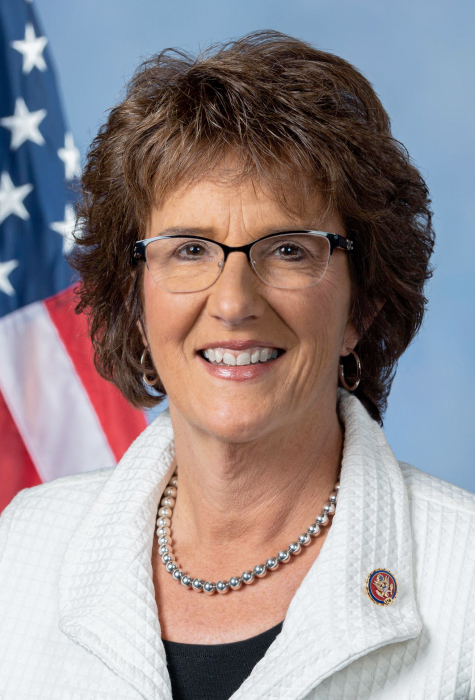Indiana Gov. Eric J. Holcomb on Tuesday signed an executive order calling for a special election in the Second Congressional District to fill the vacancy in the office of U.S. representative due to the death of Rep. Jackie Walorski.
The special election will be held concurrently with the general election on Nov. 8.
Walorski, 58, Elkhart, was one of four people killed Aug. 3 in a two-vehicle accident on Ind. 19, south of Ind. 119. The other three who lost their lives in the crash were Walorski’s district director, Zachery Potts, 27, Mishawaka; her communications director, Emma Thomson, 28, Washington, D.C.; and the driver of the other vehicle, Edith Schmucker, 56, Nappanee.
Why Is A Special Election Required?
A special election is required in this case by Article 1, Section 2 of the Constitution of the United States, as ratified in 1789, which provides that “when vacancies happen in the representation from any state, the executive authority thereof shall issue writs of election to fill such vacancies,” according to information provided by the governor’s office.
Although vacancies in other elected federal offices, such as U.S. senator or vice president, may be filled by appointment, no individual has ever been appointed to serve as a member of the U.S. House of Representatives.
A special election is required to be held under Indiana code 3-10-8-1(3): “Whenever a vacancy occurs in the office of United States representative, unless the vacancy occurs less than 74 days before the Nov. 8, 2022, general election.”
Indiana Code 3-10-8-3 states that the governor shall order a special election by issuing a writ of election directed to the circuit court clerk of each county located wholly or partially within the election district, according to the information provided by the governor’s office. The writ must specify the election district in which the election is to be held, the cause and object of the election, the name of the person whose office is vacant and the day on which the election will be held.
Each circuit court clerk, under Indiana code 3-10-8-4, required to conduct a special election is required to publish a legal notice not later than 21 days before the special election listing the title of the office, the names and addresses of all candidates who have filed for the office under the proper political party or independent candidate, the date of the election, the hours during which the polls will be open and the dates, times and locations of voting at the circuit court clerk’s office and at satellite offices of the circuit court clerk established under state law.
Once The Winner Is Determined
The purpose of the special election is to fill the vacancy existing in the Second Congressional District for the remainder of the term of Walorski, who was elected in November 2020 by the voters of the District as its boundaries existed on that date, to fill a two-year term. The term began at noon Jan. 3, 2021, and ends at noon Jan. 3, 2023.
In the past, according to information provided, the U.S. House has promptly seated the winner of a special election as soon as possible following the special election so that the voters would be represented in Congress as soon as possible during the final months remaining in that term. That assumes that there are no anticipated recounts or other disputes regarding which candidate won the special election.
How The Major Political Parties Candidates Are Chosen
So how are the candidates of the major political parties – Democrats and Republicans – chosen for the special election ballot?
Indiana code sets forth a procedure for the two major parties to nominate candidates for the special election: A caucus of the eligible precinct committeemen, called by the state chair of each major party, in which the precinct committeemen who “are entitled to vote for the office for which a candidate is to be selected” can participate.
In this case, since the office to be selected is the Second Congressional District – as it existed for the November 2020 election – the precinct committeemen of the “old” District 2 will be the individuals entitled to participate in the caucus to fill the special election vacancy for that office.
The state chairman, of the chairman’s designee, will issue the call for the caucus, which will state the purpose, date, time and place of the meeting and be sent by first class U.S. mail to all persons eligible to participate in the caucus at least 10 days before the meeting. A copy of the notice also must be filed with the Election Division not later than noon 10 days before the meeting.
Ordinarily, the action necessary to fill a vacancy in this case must be taken within 30 days after the occurrence of the vacancy, Indiana code provides that in the specific case of a special election called by the governor, a certificate of nomination must be filed with the Indiana Election Division not later than noon, 74 days before the date of the election, meaning noon Aug. 26.
A major party candidate who wants to be chosen by their party’s caucus must file a declaration of candidacy with both the Indiana Election Division and the chair of the party caucus.
After a major political party caucus chooses its candidate for the special election, the choice must be certified using the certification of nomination to the Indiana Election Division not later than noon Aug. 26. State law also notes the certificate of nomination must be filed within three days after the selection of the candidate.
Other Party Candidates
The Libertarian Party can nominate a candidate by first filing a notice of intent to fill the vacancy with the Indiana Election Division no later than noon, 10 days before the state committee of the Libertarian Party fills the vacancy. The Libertarian Party must then file state form CAN-57 to document the selection of the candidate and the candidate’s written consent to be nominated with the Indiana Election Division not later than noon three days after the candidate selection and not later than noon Aug. 26.
An independent candidate or the candidate of another political party not entitled to automatic ballot access under Indiana law can nominate a candidate for the special election by petition. To be placed on the special election ballot, the candidate would be required to obtain the signatures of at least 4,538 registered voters within the “old” boundaries of the Second District, submit those petitions to the various county voter registration offices for certification and then file the county-certified petitions, plus State Form CAN-59, the candidate’s consent to be nominated for the special election, with the Indiana Election Division, not later than noon Aug. 26.
A write-in candidate may file State Form CAN-55 with the Election Division not later than noon Aug. 26. Although the name of a write-in candidate will not be printed on any ballot, a write-in vote cast for a declared write-in candidate who has timely filed the CAN-55 form will be counted.
How Will Republican Candidate Be Chosen To Fill Ballot Vacancy At Nov. 2022 Election?
The full two-year term for the “new” Second Congressional District (noon Jan. 3, 2023, to noon Jan. 3, 2025) will be on the general election ballot. The Republican Party will fill the general election ballot vacancy for the District by using the precinct committeemen caucus processed previously described, with some significant distinctions, the information provided states.
First, the various actions to fill the ballot vacancy for the general election, such as notice of the caucus, selection of a candidate and certification of the candidate must be completed not later than noon 30 days after the occurrence of the vacancy. The co-directors of the Indiana Election Division notified the Republican State Party chair of the ballot vacancy on Thursday.
Secondly, the precinct committeemen eligible to participate in this caucus will be a somewhat different group of individuals, namely the precinct committeemen of precincts within the boundaries of the District established for the 2023-25 term.
The Democratic and Libertarian parties will not need to take any further action to nominate candidates for the new Second Congressional District at the Nov. 8 general election because the two parties already named their candidates. The Democrat is Paul Steury, Libertarian is William Henry and an Independent (write-in) is Mike Hubbard.
The deadlines for an independent or other minor party candidate to file for November’s general election have passed.
The Republican Party will determine the order in which the two precinct committeemen caucuses to fill the ballot vacancy or nominate a candidate for the special election will be conducted.
Eligible Voters In Special Election
All voters in the Second Congressional District are not necessarily eligible to vote in the special election.
If the special election and general election are held at the same time on Nov. 8, voters in Elkhart, Fulton, Marshall, Miami, Pulaski, St. Joseph, Starke and Wabash counties will have both the special election and general election for District 2 on their ballot. Voters in Cass County will not have the special election on their ballot in November. Prior to redistricting, Cass County was wholly contained within the Fourth Congressional District and therefore, ineligible to vote in the special election. Only the candidates for the new term of office in District 2 will appear on their November ballot for voters in the roughly eastern half of the county. The western half is generally in District 4.
Not all voters in LaPorte County will have the special election on their ballot in November. Generally, voters in the eastern portion of the county will have both the special election and general election for District 2 on their ballot. Some voters will have the special election for District 2 and the general election for District 1 on their ballot because the voters were in the “old” District 2 and are eligible to vote in the special election to select a person to fill the remainder of the term of office. Some voters will only have District 2 on their general election ballot, but not the special election because the area was previously in District 1 before being drawn into the new District 2. Some voters will only have District 1 on their ballot, as the northwestern corner of the county did not change between the “old” and “new” maps.
Not all voters in Kosciusko County will have the special election on their ballot in November. Generally, voters in the western half of the county will have both the special election and general election for District 2 on their ballot. Some voters will have the special election for District 2 and the general election for District 3 on their ballot because the voters were in the “old” District 2 and are eligible to vote in the special election to select a person to fill the remainder of the term of office. Some voters will only have District 2 on their general election ballot, but not the special election because the area was previously in District 3 before being drawn into the new District 2. Some voters will only have District 3 on their ballot, as the northwestern corner of the county did not change between the “old” and “new” maps.





